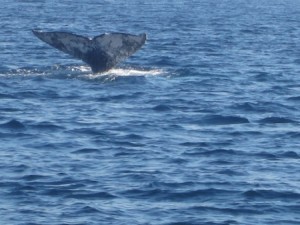In his 1841 travelogue, “Two Years Before the Mast,” sailor Richard Henry Dana described seeing gray whales for the first time, on their migration south to Mexico: “For the first few days…we watched them with great interest–calling out ‘there she blows!’ every time we saw the spout of one breaking the surface of the water; but they soon became so common that we took little notice of them.”
The Pilgrim’s peaceful, hide-trading voyage fortunately occurred before whalers discovered gray whales’ breeding grounds in 1857 and harpooned them to the edge of extinction. Whalers feared grays more than any other whale because of their defensive tactic of surfacing under big boats (often splitting them in half) and attacking smaller ones. This protective behavior earned grays the name “devil fish.”
Protected since 1947 by the International Whaling Commission, the Pacific’s gray whale population has grown enough that the U.S. removed it from the Endangered Species list in 1994. Today, people watch gray whales on their annual, 12,000-mile- roundtrip migration with the same fascination that Dana felt 170 years ago. Spotting (and often hearing) their sudden spouts, seeing their dark bodies gleam as they surface and watching their gray, barnacle-mottled flukes wave as they dive makes us appreciate how much whales and other ocean animals still depend on our continued protection.

Marketing veteran Ellen Girardeau Kempler is founder and chief navigator of Laguna-based Gold Boat Journeys. She specializes in writing and editing, digital content development, marketing strategies and communications training. Contact her at [email protected].





